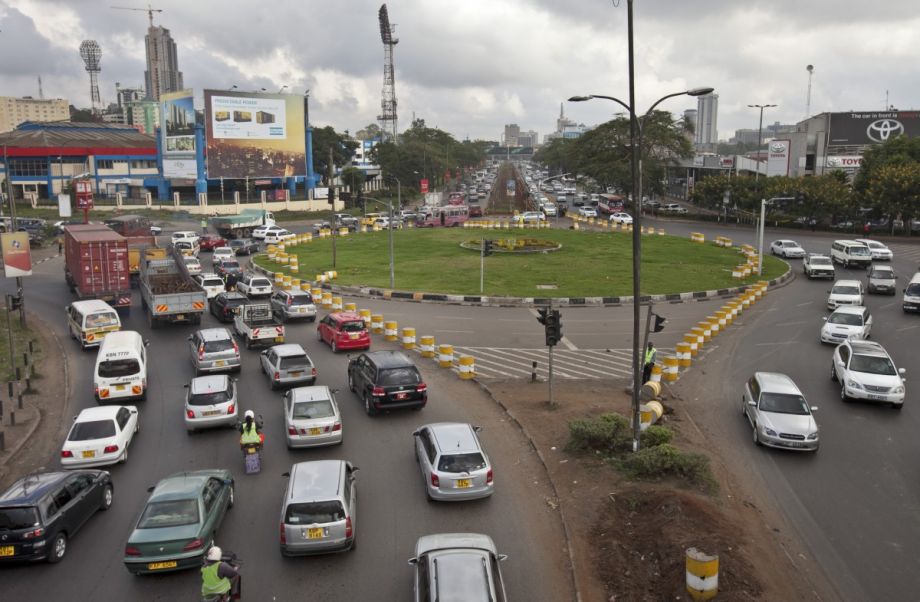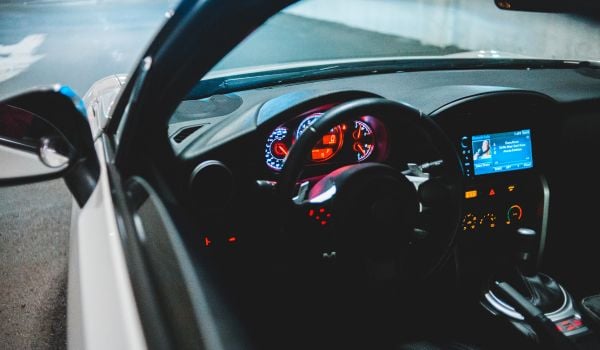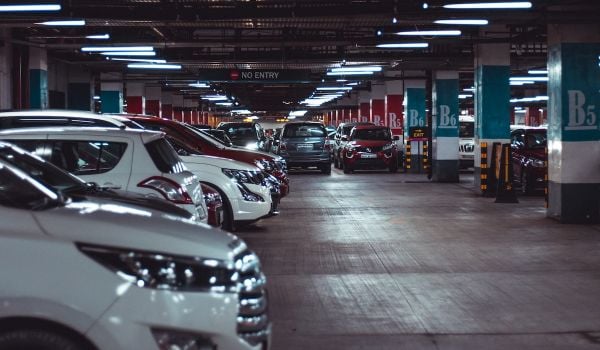UPDATE: On Tuesday, the Governor of Nairobi City County yielded to public pressure and agreed to allow right turns on two of the five roundabouts until Friday, when the Southern Bypass is slated to open.
“Very very very busy, we’re using very many verys,” said a Nairobi traffic reporter last week as he grasped for superlatives on the radio. While the terrorist attack on a university campus some 200 miles away gripped the nation’s attention, for residents of Kenya’s capital, the week of mourning was also a week of frustration.
Monday, April 6th marked the first day of a new traffic pattern along the main north-south artery serving the central business district, as officials prepare to replace roundabouts with stoplights, a traffic management policy at odds with the thinking of U.S. road engineers.
Uhuru Highway runs 2.5 miles through the heart of Nairobi. Five multi-lane roundabouts, all of which no longer allow right turns as of last week, punctuate the thoroughfare. Kenya drives on the left, meaning that a right turn requires traveling three-quarters of a roundabout — a left turn is the easy one. The roundabouts feature traffic lights already, as well as occasional traffic marshals, but the general approach has been: If you see an opening, go for it, red light be damned.
The hope is that this latest change will speed up the journey for long-distance drivers heading straight without stopping in central Nairobi; the city lacks a ring road, although a bypass is under construction for completion this year. For drivers trying to make that dreaded right turn, they now must go to the end of Uhuru, make a U-turn, and ultimately a left toward their destination. For drivers trying to cross Uhuru, they’re screwed.
“If we had been stuck on the other side of Uhuru, it would take three to four hours,” warned Anthony Mwaura, a veteran taxi driver on a recent stop-and-go journey during Friday rush hour. At its worst, local press reported nine-mile backups that stretched all the way to the international airport on the outskirts of town.
Brutal traffic has long been a regular feature of daily life in Nairobi. In 2011, IBM ranked it one of the worst cities in the world for commuting alongside mega-jam capitals like Mexico City and Beijing. Buses, matatus (shared vans), taxis, trucks, motorcycles and private cars all compete for road space in a city that UN-Habitat, headquartered here, fingered as having an inadequate street grid.
Every month, 30,000 people move to Nairobi; that has swelled the population to nearly 3.5 million, and half live in informal settlements. The city has no comprehensive mass transit option such as subway, light rail or BRT. Buses and matatus serve most of the city, but without dedicated lanes they get caught in the same traffic morass as everyone else. And given the lack of public information on routes, it took an alt weekly to publish a bus and matatu network map.
After a week of vitriol from the general public, the Kenya National Highways Authority (Kenha) is nevertheless staying the course with the plan it announced earlier this year. “The current traffic patterns are merely temporary measures,” Njuguna Gatitu, a Kenha engineer, told the press. “The long-term goal is to install four-way signalized junctions to replace all the roundabouts along Uhuru Highway.”
Mohammed Munyanya, fellow and past chairman of the Architectural Association of Kenya, thinks that the Nairobi City County government got it backwards. “Before you remove a junction, you must facilitate a junction,” he says. “The city must be mobile.”
To his mind, the Southern Bypass should have opened before Kenha began tweaking the roundabouts. Uhuru Highway is a legacy of Nairobi’s history as a rail depot on the line connecting interior Kampala, the capital of Uganda, to coastal Kenyan port Mombasa. The road system duplicates the rail line, sending heavy trucks along the 600-mile-plus journey right through downtown. Long overdue, the Southern Bypass will divert that traffic.
But even then, Munyanya believes, “You need a working public transport system. Nairobi would be a good candidate for BRT as long as it is attractive, reliable, punctual, clean and safe so that people use them by choice.”
The only ongoing investment in Kenya’s transit infrastructure, however, is improvement of the aforementioned rail line, currently underway by a Chinese company. The Chinese have invested heavily in African infrastructure, including a superhighway from Nairobi opened in 2012 of which locals are particularly proud despite its overbearing impact on the streetscape.
Mwaura, the taxi driver, is a fan of the superhighway and wishes the same were contemplated for Uhuru. “The superhighway goes over. They should have done overroads and underroads. Overpasses for pedestrians are better because this isn’t working. It’s tough tough.”
In the mean time, Nairobians are stuck with the roundabout removal scheme, which flies in the face of conventional wisdom in the U.S. The Federal Highway Administration has reams of documents extolling the virtues of roundabouts as a safer alternative to traffic signals. Once seen as a quirky feature of European towns, they have made steady inroads in Wisconsin, Maryland and Kansas, among other states.
Admittedly, U.S. traffic planners aren’t contending with the massive volume on Nairobi’s streets. The crisis is enough to stir optimism born out of exasperation. Joseph Ngigi, also a taxi driver, is one who hasn’t complained. “I’m for the experiment,” he said. “Anything to get Nairobi moving.”

Gregory Scruggs is a Seattle-based independent journalist who writes about solutions for cities. He has covered major international forums on urbanization, climate change, and sustainable development where he has interviewed dozens of mayors and high-ranking officials in order to tell powerful stories about humanity’s urban future. He has reported at street level from more than two dozen countries on solutions to hot-button issues facing cities, from housing to transportation to civic engagement to social equity. In 2017, he won a United Nations Correspondents Association award for his coverage of global urbanization and the UN’s Habitat III summit on the future of cities. He is a member of the American Institute of Certified Planners.


_600_350_80_s_c1.jpg)



_on_a_Sunday_600_350_80_s_c1.jpeg)









